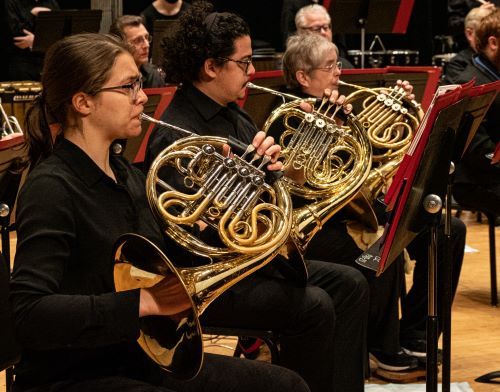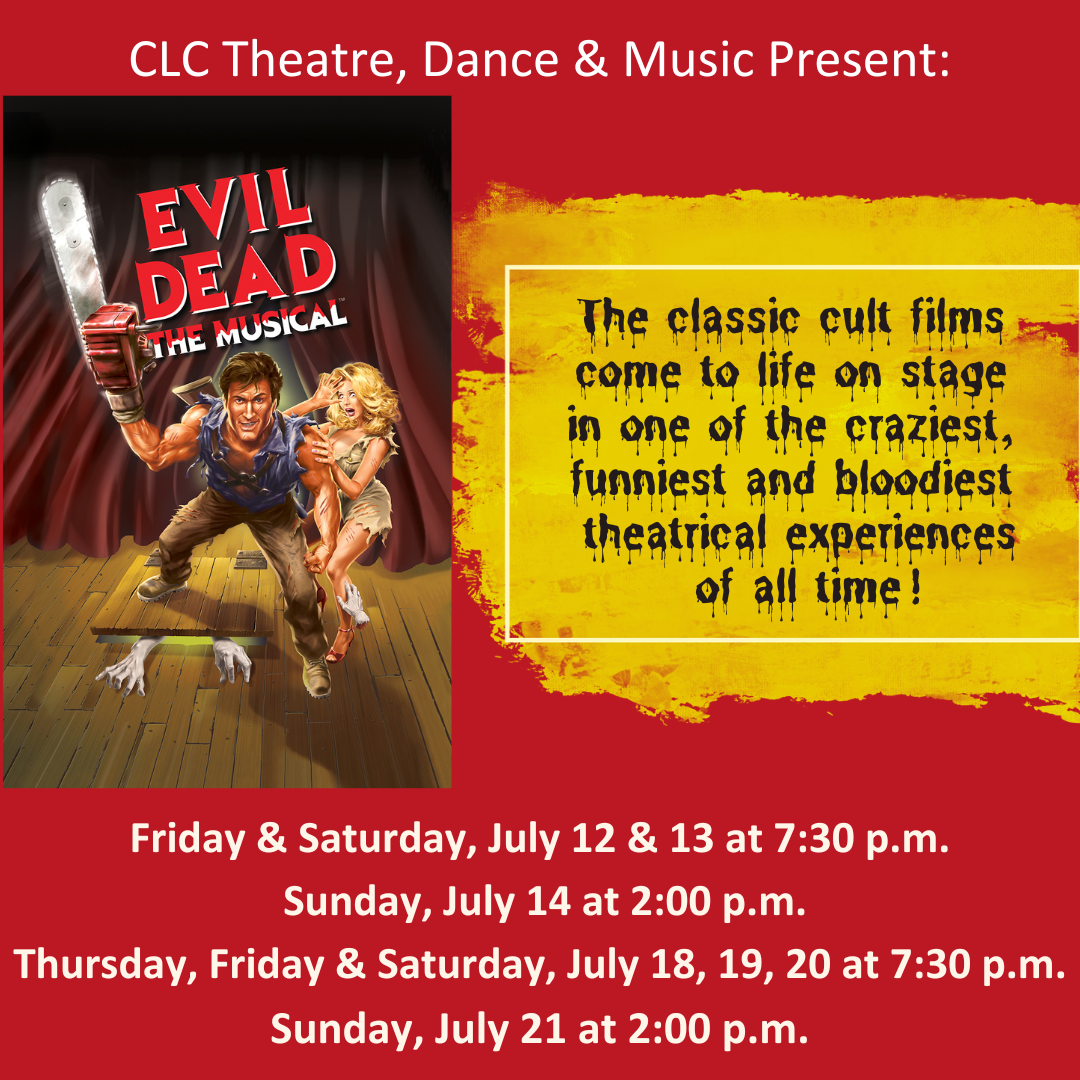
CLC Music Presents
WIND ENSEMBLE SPRING CONCERT
Sunday, April 28, 2024
4 p.m.
JLC Mainstage
Passion. Innovation. Diversity. Connection. Community.
These aren’t just hallmarks of the arts; they’re woven into the very fabric of the College of Lake County and our commitment to offering, “equitable, high-quality education, cultural enrichment, and partnerships to advance the diverse communities we serve.” Within the Communication Arts Division, we champion the belief that the arts have a unique power to reflect, unite, and transform the world by bringing diverse voices and experiences together through shared storytelling and celebration!
This season, we’re thrilled to showcase a rich array of artistic, intellectual, and cultural experiences. Revel in our exceptional music, theatre and dance performances; immerse yourself in art exhibits hosted in the beautiful Wright Community Gallery; explore our dynamic film and literary series; or engage in one of our many free community workshops and events. Each offering underscores the breadth and diversity of talent at CLC and within the wider community we serve. To learn more about our distinguished lineup for the 2023-24 season, please visit jlcenter.clcillinois.edu/
In the coming months, we also invite you to delve into the “Voices of Lake County,” a multi-year, interdisciplinary project spanning the Communication Arts, Fine Arts, and Humanities Division. This year’s theme, Sustainable Lake County, investigates environmentalism and sustainability through the lens of the arts and humanities. We will collaborate across the college and the broader Lake County community to explore how we all can live more sustainable, just, meaningful, and socially conscious lives that preserve our environment while cultivating the diverse communities that make up our region. For more information, visit www.voicesoflakecounty.com/sustainable-lake-county.
Finally, join us in further exploration and discovery by taking one of our many exciting courses in literature, creative writing, communication studies, digital media and design, philosophy, the humanities, world languages, or the vast landscape of visual and performing arts. Whatever your goal—from personal enrichment to earning a certificate or degree—we’d love to play a part in your own story of transformation!
Thank you for coming to the College of Lake County! We are excited you’re here!
Dr. Sheldon Walcher
Dean
Michael Flack, Director
AN AMERICAN FANFARE
Composed by Rick Kirby
AMAZING GRACE
Arranged by Frank Ticheli
VIENTOS Y TANGOS
Composed by Michael Gandolfi
RUSHMORE
Composed by Alfred Reed
PRELUDE, SICILIANO, AND RONDO
Composed by Malcolm Arnold
Arranged by John P. Paynter
GRAF ZEPPELIN
Composed by Carl Tieke
Arranged by Wolfgang Wössner
SYMPHONIC METAMORPHOSIS AFTER THEMES
BY CARL MARIA VON WEBER: IV. MARSCH
Composed by Paul Hindemeith
AN AMERICAN FANFARE
Composed by Rick Kirby
In this dynamic concert opener, Rick Kirby incorporates the normally hymn-like strains of America (My Country, 'Tis of Thee) into a fast and energetic fanfare. The actual melody is stated only once in its entirety, and many liberties are taken with both melodic and harmonic elements of the original.
- Program Note from publisher
AMAZING GRACE
Arranged by Frank Ticheli
I wanted my setting of Amazing Grace to reflect the powerful simplicity of the words and melody -- to be sincere, to be direct, to be honest -- and not through the use of novel harmonies and clever tricks, but by traveling traditional paths in search of truth and authenticity.
I believe that music has the power to take us to a place that words alone cannot. And so my own feelings about Amazing Grace reside in this setting itself. The harmony, texture, orchestration, and form are inseparable, intertwined so as to be perceived as a single expressive entity.
The spiritual, Amazing Grace, was written by John Newton (1725-1807), a slave ship captain who, after years of transporting slaves across the Atlantic Ocean to the New World, suddenly saw through divine grace the evilness of his acts. First published in 1835 by William Walker in The Southern Harmony, Amazing Grace has since grown to become one of the most beloved of all American spirituals.
Amazing Grace was commissioned by John Whitwell in loving memory of his father, John Harvey Whitwell. It was first performed on February 10, 1994, by the Michigan State University Wind Symphony, John Whitwell conductor.
- Program Note by Frank Ticheli
VIENTOS Y TANGOS
Composed by Michael Gandolfi
Vientos y Tangos (Winds and Tangos) was commissioned for The Frank L. Battisti 70th Birthday Commission Project and is dedicated to Frank Battisti, in recognition of his immense contributions to the advancement of concert wind literature. It was Mr. Battisti’s specific request that I write a tango for wind ensemble. In preparation for this piece, I devoted several months to the study and transcription of tangos from the early style of Juan D’arienzo and the “Tango Nievo” style of Astor Piazzolla to the current trend of “Disco/Techno Tango,” among others. After immersing myself in this listening experience, I simply allowed the most salient features of these various tangos to inform the direction of my work. The dynamic contour and the various instrumental combinations that I employ in the piece are all inspired by the traditional sounds of the bandoneon, violin, piano, and contrabass.
- Program Note by composer
RUSHMORE
Composed by Alfred Reed
A tribute to the four great faces carved in stone, this impressive Alfred Reed piece is an outstanding choice for any performance where a patriotic piece is appropriate.
Rushmore was commissioned by and is dedicated to the Rushmore Summer Music Camp, Paul F. Hedge and Lois J. Hedge, directors, on the occasion of its 10th Anniversary, 1980.
- Program Note from publisher
PRELUDE, SICILIANO, AND RONDO
Composed by Malcolm Arnold
Arranged by John P. Paynter
Born to a family of shoemakers in 1917, British composer Malcolm Arnold became a sought-after composer and trumpet performer before his twenty-fifth birthday. Arnold completed his Little Suite for Brass in 1963, adding to the competitive repertoire of British-style brass bands. Consisting of three short contrasting movements, the piece is used to this day as a “test piece” in various brass band competitions – providing a single work that all competing bands are required to perform. This suite was transcribed for full concert band in 1979 and given the name Prelude, Siciliano and Rondo showcasing John P. Paynter’s considerable skill as a transcriber as well as his apparent disapproval of the Oxford comma.
- Program Note by Christopher M. Nelson for Indiana University All-Campus Band concert program, April 2023
GRAF ZEPPELIN
Composed by Carl Teike
Arranged by Wolfgang Wössner
When one considers the lasting success of several sparkling marches by Carl Teike (1864-1922), one is generally inclined to think that this composer was able to “profit financially” from his music. This is not true at all, as this modest person whose generosity is well documented never lived in luxury: The promising career as a military musician during the times of the German empire came to an unforeseen end in Ulm.
This evidently was the reason for him to go to Potsdam, where he served on the police force. When he contracted a severe disease, he was forced to retire from police duty, and finally spent the later years of his life in Landsberg on the Warthe as a civil servant. Joachim Toeche Mittler, the well-known German authority on the history of German military music, labeled the march Count Zeppelin, which Teike originally composed in 1903 as March of the Teutons, “immortal”, and this evaluation is presumably correct. The piece is well known by several titles in many countries such as The Conqueror or March of the Air Fleet and has become a hallmark for the art of German martial music at its best.
- Program Note from publisher
SYMPHONIC METAMORPHOSIS AFTER THEMES BY CARL MARIA VON WEBER: IV. MARSCH
Composed by Paul Hindemith
Symphonic Metamorphosis premiered at the New York Philharmonic on 20 January 1944, with Artur Rodzinski conducting. It has since become one of Hindemith's more popular and enduring works. It was inspired in part by choreographer and dancer Léonide Massine, who suggested to Hindemith that he compose a ballet based on Weber’s music. However, after watching one of Massine’s ballets and discovering that Massine intended to use sets and costumes designed by Salvador Dali (an artist whom Hindemith disliked), Hindemith decided to part ways with Massine, and the project was dropped. A few years later, Hindemith decided to salvage the music and write a set of variations or metamorphoses instead.
The suite is in four movements:
I. Allegro– A confident and aggressive march with East European flavour. This movement is based on Weber’s Huit Pièces pour le pianoforte à quatre mains (Op.60), No. 4, composed in 1818.
II. Turandot, Scherzo– A whimsical and delicate movement with a distinct oriental flavor. The theme is based on the overture to Weber's Turandot (which is itself based on an original Chinese song). The middle section features the brass, woodwind, and percussion sections in turn.
III. Andantino– This slow movement is based on Weber's Six Pièces pour le pianoforte à quatre mains (Op.10), No 2, composed in 1809. The movement closes with an elaborate bit of counterpoint for the flute, which has been said to resemble bird song.
IV. Marsch– Possibly the best-known movement, it opens with a set of fanfares. Like the first movement, this one is also based on Huit Pièces pour le pianoforte à quatre mains, this time focusing on No. 7. The original theme was meant to be a funeral march; Hindemith doubles the tempo to give the previously morbid tune a jaunty, catchy feel.
The transcription was completed at Hindemith's request by his Yale University colleague, Keith Wilson.
- Program Note by Nikk Pilato
Michael Flack - Conductor
PICCOLO
Elizabeth Rehm
FLUTE
Laura Houston
Tracey Ramotar
Karla Boucek
Natalie Gahgan
OBOE
Matt Matias
CLARINET
Debbie Durham
Angelo Anello
Steve Schmidt
Steve Loerch
Rebecca Stalter
Nadia Ziyadeh-Flores
BASS CLARINET
Jay Seifried
Gabrielle Rutkowski
BASSOON
Alexander Blessing
ALTO SAXOPHONE
Tami Pilot-Matias
Chris Markgraf
TENOR SAXOPHONE
Alan Schramm
BARITONE SAXOPHONE
Marty Sviatko
TRUMPET
Tom Forkenbrock
Larry McWilliams
Nathan Stalter
Adam Keno
Michael Purcell
FRENCH HORN
Samantha Rose
Nancy Orbison
Steve Chamberlin
Stan Bouma
TROMBONE
Brian Mabus
Jeff Rosendahl
Jeff Gahgan
EUPHONIUM
Joe Kuzmanoff
TUBA
Barb Gangware
Paul Schmidt
BASS
Paul Nielsen
PERCUSSION
Dan Joyce
Bob Miller
Dan Prowse
Mallory Rasky
Mike Wolff
Upcoming Events at the JLC
JAZZ ENSEMBLES SPRING CONCERT
CLC Music
Friday, May 3 at 7:30 p.m.
CHORAL ENSEMBLES SPRING CONCERT
CLC Music
Saturday, May 4 at 4 p.m.
CONCERT BAND SPRING CONCERT
CLC Music
Wednesday, May 8 at 7:30 p.m.
EVIL DEAD THE MUSICAL
CLC Theatre
Friday & Saturday, July 12 & 13 at 7:30 p.m.
Sunday, July 14 at 2 p.m.
Thursday, Friday & Saturday, July 18, 19 & 20 at 7:30 p.m.
Sunday July 21 at 2 p.m.
Online: jlcenter.clcillinois.edu
Phone: (847) 543-2300
We hope to see you at a future event!
Email for questions: clcboxoffice@clcillinois.edu
Box Office Hours: Monday - Friday, 10 a.m. to 4 p.m.



JOIN OUR MAILING LIST
Call the JLC Box Office: (847) 543-2300
JOIN OUR EMAIL LIST
Visit the JLC website to sign up!
https://www.jlcenter.clcillinois.edu/
See bottom right on home page.
College of Lake County
Board of Trustees
Torrie Mark Newsome, J.D., Chair
Paul Virgilio, B.S., S.E., P.E., Vice Chair
Allena Barbato, J.D., L.M.F.T., Secretary
William M. Griffin, Ed.D.
Amanda D. Howland, J.D.
Julie B. Shroka, M.A.
Gerri Songer, M.A.
Sulma Teruel, Student Trustee
Lori Suddick, Ed.D., President
Trustees Emeriti
Richard A. Anderson, J.D.
William M. Griffin, Ed.D. (2021-2023)
Patricia Jones, M.Ed.
Barbara D. Oilschlager, M.Ed.
James Lumber Center Staff
Alisa Baum
Executive Director
Jessica Daly
Patron Services Coordinator
Jeremy Eiden
Technical Coordinator
Judie Katz
Marketing & Communications Coordinator
Leslie Baraboo
Marketing & Communications Analyst
Kim Dizzonne
Accounting Associate
Peter Hansen
Technical Production Assistant
We respectfully acknowledge that the College of Lake County is on the ancestral homelands of the Kickapoo, Peoria, Potawatomi and other native peoples. We recognize the longstanding significance of these lands for indigenous peoples past, present and future. Historical awareness of indigenous exclusion and erasure is critically important to preventing further atrocities. The College of Lake County pledges to acknowledge the grave injustices of the past and pledges to create awareness and advance education that invites truth.



_FYXX.png)
